Trauma & Nerve Damage to Teeth
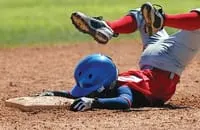
This article provides answers to common questions about the essence of what happens and what treatment is needed when injury to teeth involves the dental pulp. The dental pulp is the living tissue within the root canal(s) of teeth that contains blood vessels, nerves and connective tissues. Not only do the injuries and their treatment vary, but they are also influenced by the type of tooth, whether deciduous (primary or baby) teeth or permanent (adult) teeth, as well as their stage of growth and development. Treatment of dental pulp (nerve) injuries is called root canal or endodontic treatment.

What is endodontic treatment?
Root canal.
Endodontic treatment involves the root canal(s) inside of the tooth derived from “Endo” the Greek word for “inside” and “odont” is the Greek for “tooth.” To understand endodontic treatment, it helps to know something about the anatomy of the tooth. The body of a tooth is made of dentin with the crown covered by enamel, one of the hardest substances produced in nature. Inside the tooth, is a soft tissue called the pulp containing blood vessels, nerves and connective tissue, which creates the surrounding dentin and enamel during growth and development.
The pulp extends from the crown of the tooth to the tip of the roots where it connects to the tissues surrounding the root. Although the pulp is important during a tooth's growth and development, once it is fully mature the tooth can survive without the pulp.
Who performs endodontic treatment for injuries to children's and/or adult's teeth?
All dentists, including your general dentist, received training in endodontic treatment in dental school. General dentists can perform endodontic procedures along with other dental procedures, but often they refer patients needing endodontic treatment to endodontists. Pediatric dentists also receive training in the treatment of endodontic issues for primary (baby) teeth.
Endodontists are dentists with special training in endodontic procedures. They provide only endodontic services in their practices because they are specialists. To become specialists, they complete an additional two or more years of advanced training in endodontics after dental school. They perform routine as well as difficult and very complex endodontic procedures, including endodontic surgery. Endodontists are also experienced at finding the cause of oral and facial pain that has been difficult to diagnose.

How will my injury be treated?
Chipped teeth account for the majority of all dental injuries. Dislodged or knocked-out teeth are examples of less frequent, but more severe injuries. Treatment depends on the type, location and severity of each injury. Any dental injury involving the dental pulp of a tooth requires examination by a dentist, pediatric dentist or an endodontist immediately. Sometimes, neighboring teeth suffer an additional, unnoticed injury that will only be detected by a thorough dental exam that will include taking radiographs (x-ray pictures) of the teeth and surrounding bone structures.
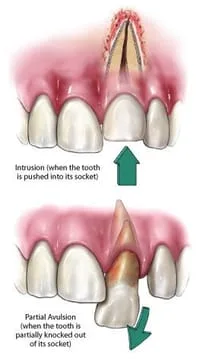
Dislodged (Luxated) Teeth: During an injury, a tooth may be pushed sideways, out of, or into its socket. Your endodontist, pediatric dentist or general dentist will reposition and possibly stabilize your tooth with a splint for few weeks. Root canal treatment is usually needed for permanent teeth that have been dislodged and should be started a few days following the injury. Medication such as calcium hydroxide may be put inside the tooth as part of the root canal treatment. A permanent root canal filling will be placed at a later date.
Children between 7 and 12 years old may not need root canal treatment since their teeth are still developing. For these injuries, a dentist, pediatric dentist or endodontist will monitor the healing carefully with clinical and radiographic (x-ray) examination and intervene immediately if any unfavorable changes appear. Therefore, multiple follow-up appointments are likely to be needed. New research indicates that stem cells present in the pulps of young people's teeth can be stimulated to complete root growth and heal the pulp following injuries or infection.
Knocked-Out (Avulsed) Teeth: If a tooth is completely knocked out of your mouth, time is of the essence. The tooth should be handled very gently, avoiding touching the root surface itself. If it is dirty, quickly and gently rinse it in cold water (either tap or clean bottled water). Do not use soap or any other cleaning agent, and never scrape or brush the tooth. If possible, the tooth should be placed back into its socket as soon as possible. The less time the tooth is out of its socket, the better the chance for saving it. Call a dentist immediately!
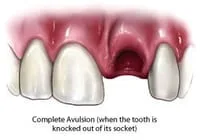
If you cannot put the tooth back in its socket, it is best to keep it in milk to prevent the root surface from drying out. Doing this will keep the living cells moist and alive for a few hours. Another option is to simply put the tooth in the patient's mouth between the gum and cheek or, collect the patient's own saliva in a cup and to keep the tooth in it temporarily until getting to the dentist. Do not store or transport the tooth in regular tap water or in a dry cloth/kitchen paper towel because the root surface cells will not tolerate it and will die, greatly diminishing the long-term prospects for the tooth.
Once the tooth has been put back in its socket, your dentist will evaluate it and will check for any other dental and facial injuries. If the tooth has not been placed back into its socket, your dentist will clean it carefully and replace it. A stabilizing splint will be placed for a few weeks. Depending on the stage of root development, your dentist or endodontist may start root canal treatment a week or two later. A medication may be placed inside the tooth followed by a permanent root canal filling at a later date.
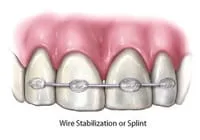
The length of time the tooth was out of the mouth and the way the tooth was stored before reaching the dentist very much influences the chances of saving the tooth. Again, immediate treatment is essential. Taking all these factors into account, your dentist, pediatric dentist or endodontist may discuss other treatment options with you.
Root Fractures: A traumatic injury to the tooth may also result in a vertical or horizontal root fracture. The direction and also location of the fracture determine the long-term outlook of the tooth. If a horizontal fracture is close to the root tip, the chances for success are much better. However, the closer the fracture is to the vicinity of the gum line and the more vertical it is, the poorer the long-term success rate. Sometimes, stabilization with a splint is required for a period of time.
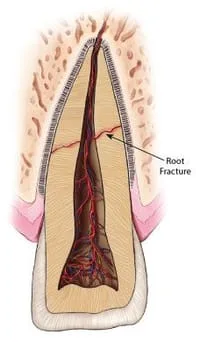
Do traumatic dental injuries differ in children?
Chipped primary (baby) teeth can be restored quite esthetically. Dislodged primary teeth can, in rare cases, be repositioned. However, primary teeth that have been knocked out typically should not be replanted. This is because the replantation of a knocked-out primary tooth may cause further and permanent damage to the underlying permanent tooth that is growing inside the bone.
Children's and adolescents' permanent teeth that are not fully developed at the time of the injury need special attention and careful follow up, but not all of them will need root canal treatment. In an immature permanent tooth, the blood supply to the tooth and the presence of stem cells in the region may enable your dentist, pediatric dentist or endodontist to stimulate continued root growth.
Endodontists have the knowledge and skill to treat incompletely formed roots in children so that, in some instances, the roots can continue to develop. Endodontists will do all that is possible to save the natural tooth. These specialists are the logical source of information and expertise for children who are victims of dental trauma.
Will the tooth need any additional care or treatment?
The nature of the injury, the length of time from injury to treatment, how your tooth was cared for after the injury and your body's response — all affect the long-term health of the tooth. Timely treatment is particularly important with dislodged or knocked-out teeth in order to prevent root resorption.

Resorption, an eating away of the root over time, occurs when your body, through its own defense mechanisms, begins to reject your own tooth in response to the traumatic injury. Following the injury, you should return to your dentist, pediatric dentist or endodontist to have the tooth examined and/or treated at regular intervals for up to five years to ensure that root resorption is not occurring and that surrounding tissues continue to heal. It has to be noted that some types of resorption are untreatable.
